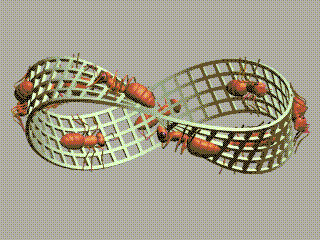The "Möbius Magic" Puzzles
Here I present the final "chapter" regarding single closed loop magics magics with standard stringing.
|
After making the odd numbered tile Magic Myths and then separating all magics into two types (A and B), I thought I had covered all possible standard stringing cases, and actually I had. But what I have covered in the past was regarding those magics which had TWO sides! You know... front side and back side. And even the magic myths (which are odd tiled) have two sides, but in their case, it is in three dimensions (the same goes with the type B magics). Now imagine a magic puzzle which has only ONE side, i.e. it is connected in the same way as a Möbius Strip:
You may say... "Oh no! Wouldn't the strings of the
magic be stretched too much and then break???" First a little bit of theoretical stuff. You probably know the normal 8-tile Rubik's, as well the the 8-tile "Frame" puzzle (e.g. Flexible Tetragon). The normal puzzle and the Frame are different in that one tile is connected differently than the rest, i.e. it has a half turn in both sides. That creates a parity difference between the two puzzles making them different. Or you may call them type A and type B as I defined them in the past. But what if, only one side of the tile was connected differently? Then we would have a "half parity" (don't know if that makes sense LOL), or in other words a half turn which is the way a Möbius Strip is made! So lets go to the stringing part! While stringing the tiles, the most tricky part is obviously the last step. It is the step where you must make the half turn twist to give the puzzle the Möbius Strip form. But after understanding how the last part should be connected (to close the loop) and by moving two tiles on the other side (which *does not* affect the final form of the puzzle), voila! Now, the final stringing can be easily done, without any stretching whatsoever. In other words, if we have a magic puzzle in a Möbius Strip form, the stringing of the puzzle allows flat shapes to be formed too! So why string it in the (sometimes overstretched) Möbius Strip form? Using the equivalent flat shape to string it is much easier! Of course, it's supposed to have the shape of a Möbius Strip, and we want to see it right? Well, we can't easily see it on an 8-tile magic (big angles between very few tiles), but we can certainly do so on a 24-tile magic!!! (in fact, the more the tiles, the smaller the angles between the tiles to reach the Möbius Strip form). So here, after the Magic Myths, I present a new type of magics, the
Möbius Magics!!! Note that, for consistent standard stringing,
(i.e. to avoid any sort of bandaging) we are forced to use an *even*
number of tiles. Firstly, I present the "Magic Line", an 8-tile magic, which has Mr Escher's ant theme (as seen in the animated pictures above).
A few more (scrambled) possible shapes:
In the above picture, it is easy to see the differences between all those three magics. The Rubik's Magic (top), can take the form of a circle with no "extensions". The Flexible Tetragon (bottom right), can have an internal extension (+) and and internal extension (-), which preserves the "flatness" of the magic. And finally, the Magic Line (bottom left), which has a single extension. Now believe me, ALL closed loop 8-tile shapes with any other number of extensions can be transformed to one of those three magics. The reason is, each of the magics above is always equivalent with any other magic which has an additional even number of either external extensions or internal extensions. After understanding this, it is easy to make a fast check that covers all possibilities. ;-) By adding extra half turns, we will still end up with Type A Magics, Type B Magics, or Möbius Magics.
And I also present the "Magic Strip", which also has the ant theme, and whose 24 tiles allow it to take its "natural" Möbius Strip form.
|
|
Summarising, the Möbius Magics belong to a new style magic series (which have many combinations and are extremely confusing to play with), different from the normal Rubik's (Type A) or the ones with a parity difference (Type B). The stringing of the square tiles may be based on the rubiks magics, but the concept is unique. |
To build this puzzle you will need some strings, plastic tiles, and some nice
paper tiles.
For information of how to connect/number the tiles and the strings, visit
two brilliant articles here
and here,
(courtesy of Twisty Puzzles
articles).
Please let me know of any comments or suggestions. Thanks! :-)
